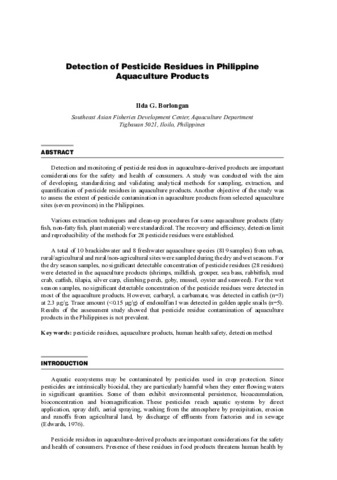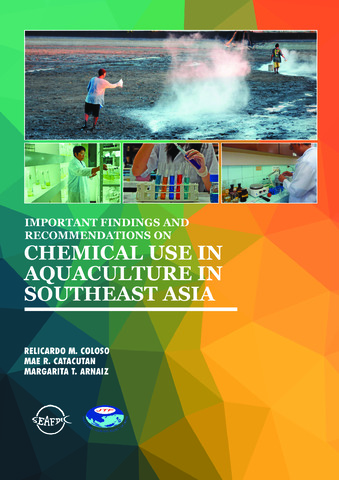Detection of pesticide residues in Philippine aquaculture products
| dc.contributor.author | Borlongan, Ilda G. | |
| dc.contributor.editor | Nagasawa, Kazuya | |
| dc.date.accessioned | 2020-07-23T00:39:08Z | |
| dc.date.available | 2020-07-23T00:39:08Z | |
| dc.date.issued | 2005-03 | |
| dc.identifier.citation | Borlongan, I. G. (2005). Detection of pesticide residues in Philippine aquaculture products. In K. Nagasawa (Ed.), Recent Advances in Diagnosis and Prevention of Fish and Shrimp Diseases in Southeast Asia (pp. 329–335). Tigbauan, Iloilo, Philippines: Aquaculture Department, Southeast Asian Fisheries Development Center. | en |
| dc.identifier.isbn | 9718511732 | |
| dc.identifier.uri | http://hdl.handle.net/10862/5938 | |
| dc.description.abstract | Detection and monitoring of pesticide residues in aquaculture-derived products are important considerations for the safety and health of consumers. A study was conducted with the aim of developing, standardizing and validating analytical methods for sampling, extraction, and quantification of pesticide residues in aquaculture products. Another objective of the study was to assess the extent of pesticide contamination in aquaculture products from selected aquaculture sites (seven provinces) in the Philippines. Various extraction techniques and clean-up procedures for some aquaculture products (fatty fish, non-fatty fish, plant material) were standardized. The recovery and efficiency, detection limit and reproducibility of the methods for 28 pesticide residues were established. A total of 10 brackishwater and 8 freshwater aquaculture species (819 samples) from urban, rural/agricultural and rural/non-agricultural sites were sampled during the dry and wet seasons. For the dry season samples, no significant detectable concentration of pesticide residues (28 residues) were detected in the aquaculture products (shrimps, milkfish, grouper, sea bass, rabbitfish, mud crab, catfish, tilapia, silver carp, climbing perch, goby, mussel, oyster and seaweed). For the wet season samples, no significant detectable concentration of the pesticide residues were detected in most of the aquaculture products. However, carbaryl, a carbamate, was detected in catfish (n=3) at 2.3 μg/g. Trace amount (<0.15 μg/g) of endosulfan I was detected in golden apple snails (n=5). Results of the assessment study showed that pesticide residue contamination of aquaculture products in the Philippines is not prevalent. | en |
| dc.language.iso | en | en |
| dc.publisher | Aquaculture Department, Southeast Asian Fisheries Development Center | en |
| dc.subject | polycyclic aromatic hydrocarbons | en |
| dc.subject | contamination | en |
| dc.title | Detection of pesticide residues in Philippine aquaculture products | en |
| dc.type | Book chapter | en |
| dc.citation.spage | 329 | en |
| dc.citation.epage | 335 | en |
| dc.citation.bookTitle | Recent Advances in Diagnosis and Prevention of Fish and Shrimp Diseases in Southeast Asia | en |
| dc.subject.asfa | polychlorinated biphenyls | en |
| dc.subject.asfa | pesticide residues | en |
| dc.subject.asfa | aquaculture products | en |
| dc.subject.asfa | public health | en |
| dc.subject.asfa | aquaculture | en |
| dc.subject.asfa | pesticides | en |
| dc.subject.asfa | detection | en |
| dc.subject.asfa | PCB | en |
このアイテムのファイル
このアイテムは次のコレクションに所属しています
-
Recent Advances in Diagnosis and Prevention of Fish and Shrimp Diseases in Southeast Asia [43]
Terminal Report of the Regional Fish Disease Project on “Development of Fish Disease Inspection Methodologies for Artificially-Bred Seeds” Funded by the Government of Japan Trust Fund from 2000 to 2004


 AQD Access only
AQD Access only



